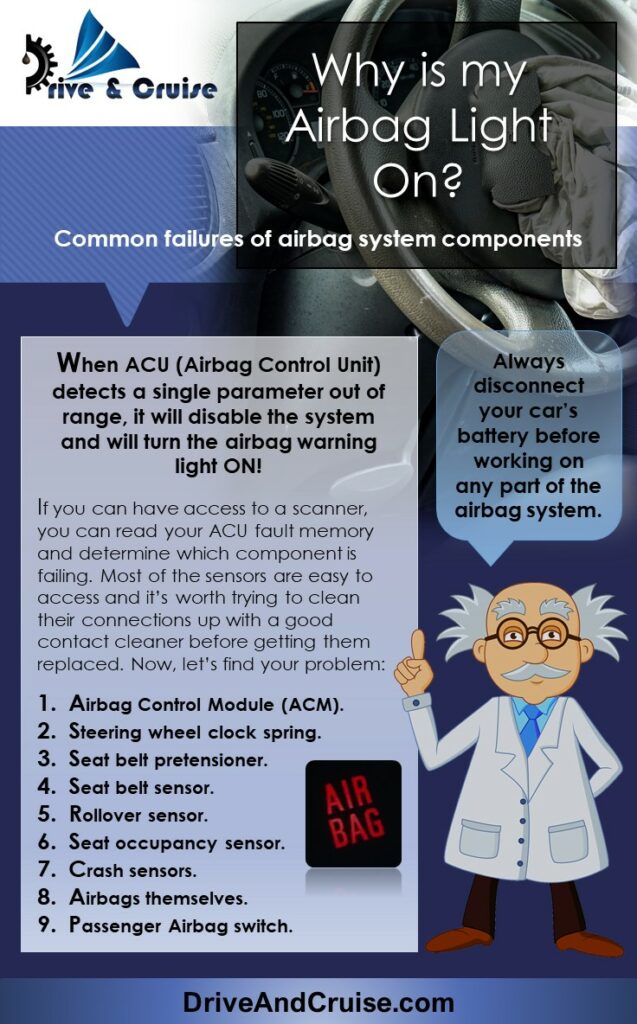![]()
Why is my Airbag Light On? [System Failures]
DISCLAIMER: AS AN AMAZON ASSOCIATE I EARN FROM QUALIFYING PURCHASES. THIS POST CONTAINS AFFILIATE LINKS THAT WILL REWARD ME MONETARILY OR OTHERWISE WHEN YOU USE THEM TO MAKE QUALIFYING PURCHASES. FOR MORE INFORMATION, PLEASE READ MY EARNINGS DISCLAIMER.
|
You can have your airbag light on for many reasons. If the ACU (or Airbag Control Unit) detects a single parameter out of range, it will disable the system and will turn the airbag warning light ON the dashboard to let the driver know that there is a problem that needs to be fixed asap.
If your airbag light is lit on your dashboard it means that there is a failure in your airbag system and it will be disabled until you fix this problem. Driving your car in that condition might be dangerous and not just because you are driving without the airbags’ protection, but because you could also suffer serious injuries if one of the airbags is accidentally deployed.
Airbag systems are really “lifesavers” when they are used properly in combination with the safety belts, but they can also become “deadly” if they are accidentally triggered! That’s why ACUs are constantly monitoring the airbags’ status, the sensors, the wiring, voltage, and electrical resistance of all their components in order to prevent accidental detonations:
All this monitoring is also meant to guarantee that the system is in perfect operating condition and that it is going to work properly in case of an accident. If the supplemental restraint system (SRS) fails, the car’s onboard computer will turn the warning light ON:

In this article, I am going to list all the components in airbag systems, and explain how they can trigger the dashboard airbag light (when some of these components fail). I will also give you some insight into how to make this light go away.
Is an airbag really that important?
The airbag is a passive safety device that was first installed in commercial vehicles in the early ’70s as a luxury device. It was a different time when the security of the car’s passengers wasn’t regarded as something that important.
As time passed, consumer and government awareness of passenger safety increased and vehicle manufacturers started to include safety features in their models as standard equipment.
In the ’80s more and more vehicles started to be equipped with airbags, and in the ’90s, almost every new car sold in the existing market came equipped with them. These systems became more relevant at the end of the decade when their installation in new vehicles became mandatory in most of the advanced countries in the world.
The complexity of the airbag system
Ever since the early ’70s, these systems have become more complex. They have been improved to the point that they have almost no side effects.
Modern cars come with more than just one airbag. A car now can have from 4 to 8 airbags, including lateral and window protection (some even have knee protection for the front passengers):
As the number of airbags in cars increased, the possibility of airbag failure increased as well. But to be fair, new cars that we have today don’t tend to have airbag problems:
The threaded airbag light is prone to appear in cars older than 10 years.
Improvements were made to the intelligence of these mechanisms and that decreased the possibility that one of the airbag components will fail.
Airbag system components
Airbag systems have a control module commonly known as ACU (Airbag Control Unit). This unit is the “brain” of the system.
It’s connected to a variety of sensors that collect data such as vehicle speed, acceleration and deceleration, seat occupancy, brake pressure, seat belt status, and most important of all, impact sensors. According to the type of airbag unit and age of the car, there can be other sensors that are mostly used to make the airbag deployment more efficient and safe for the car’s passengers.
In the case of an accident, the crash sensors will send a signal to the ACU, which calculates in a split second if it’s required and safe to deploy the airbags. If the ACU determines that the airbags must be deployed, it will use all the information gathered by its sensors to determine the deployment speed of the airbags and if safety belt pretensioners need to be activated.

Image source
In modern systems, it will decide also WHICH airbags should be deployed, among other things. Airbag systems most common components and failures include:
- Airbag Control Module (ACM). This module manages the whole airbag system and a problem can occur if it gets burnt or damaged. It needs to be replaced after a crash in which the airbags had to be deployed.
- Steering wheel clock spring. It’s a flex cable that is located at the back of the steering wheel that allows communication between the driver’s airbag and the ACM while the steering wheel rotates. A common problem is that, with time, the wires wear out and the brakes as well, preventing these two parts from communicating.
- Seat belt pretensioner. The pretensioner is responsible for tightening the seat belts and keeping the driver or the front passenger tight into their seats (in order to prevent passengers from getting too close to the airbags when they are deployed). These parts work by the activation of a light explosive charge and have to be replaced after a crash. They can also fail, get damaged, or have connection or wiring problems.
- Seat belt sensor. It senses if a seat belt has been fastened. Some sensors can also sense the tightness of the seatbelt. They can fail or present connection or wiring issues.
- Rollover sensor. This sensor is more common in modern airbag systems and is usually located inside the ACU itself. If it fails, the airbag light will come ON.
- Seat occupancy sensor. It sends a signal to the Airbag Control Unit to inform if someone is seated in that place, and the weight of the passenger, helping to calculate the airbags’ deployment speed. These sensors can also get broken or have electrical and connection problems.
- Crash sensors. These sensors are located at several parts of the car, detecting if the car has suffered an impact and they are sending a signal to the ACU. They can fail or have problems with their wiring and connectors.
- Airbags. It’s pretty uncommon that the airbags themselves are defective. Most of the time, airbags appear faulty and the light turns ON because of electrical problems.
- Passenger Airbag is OFF. Some cars are equipped with a switch to turn the passenger airbag(s) off, so they don’t deploy if the car suffers an accident and that seat is empty. The airbag light will turn on if this switch or its connections are defective.
Wiring and connectors
This topic needs special attention because airbag system components themselves are built under many quality control and safety standards that make them very reliable.
However, there is a weak point in these systems, and that is the electrical part, wiring, and connectors.
As mentioned before, the Airbag Control Units are constantly monitoring the components of the system, and any change in the electrical resistance of any of them might suggest an electrical failure.
With the passing of time, the airbag’s electrical connectors can get deteriorated, rusty, or just dirty. When an ACU is scanned for failures, it will show all kinds of things from circuit resistance being too high, circuit voltage too low, open circuit, or short to ground (or to positive).
When a deeper revision of that component is performed and if it is found to be in good condition, it ends up that what was causing the ACU to read that the component was failing was a connection flaw, caused by a bad connection or a defective wire.
Feel free to save the infoPin below for your future Reference :
Making the Airbag Light go away
If you can have access to a scanner, you can read your ACU fault memory and determine which component is failing. Most of the sensors are easy to access and it’s worth trying to clean their connections up with a good contact cleaner before getting them replaced.
These tasks can be performed by any person with medium mechanical skills. Repairing costs of airbag systems are very expensive, so if you have the right tools, there are a lot of tutorials available on YouTube.
You just have to follow the instructions and always disconnect your car’s battery before working on any part of the airbag system. When it comes to the airbags themselves, or to items that require the airbags to be removed (like the steering wheel clock spring), I would suggest you take your car to a shop to have it fixed by professional staff.
Manipulating airbags is too risky: a simple mistake can cost your life or leave you with serious injuries. Contact your local mechanic for more information on your problem:
Attention! This article is for informational purposes ONLY and is NOT a replacement for professional advice! ALWAYS consult your local specialist for an appropriate solution to your problem. All statements, prices, contact information, recommendations, and reviews contained herein came from sources that we believe to be reliable, but the accuracy or completeness thereof is not guaranteed. Please contact the service provider for complete details and updates.


